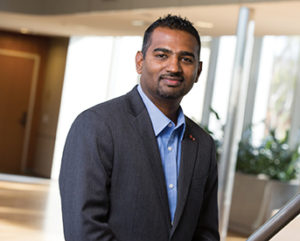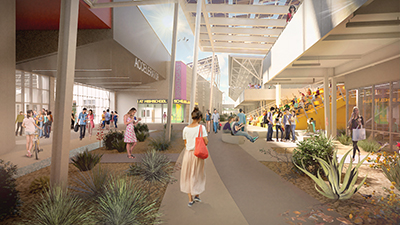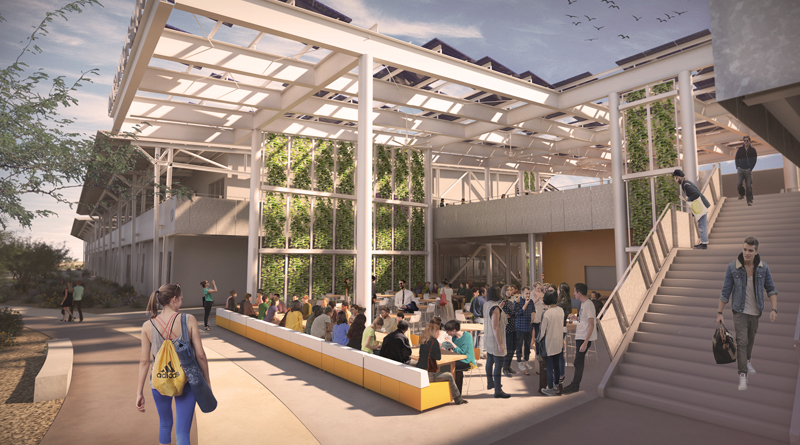Thermal Mass 2.0: Reinventing Energy Design for User Experience
By Premnath Sundharam

WADDELL, Ariz. — Sustainability, as a concept, has become increasingly more sophisticated, extending beyond the built environment into the realm of how a building accommodates and interacts with people. New sustainable materials and systems arrive on the scene every day with promises to enhance the user experience. To remain on the cutting edge of these emerging technologies, DLR Group leans on research to inform our designs and to test the next application of sustainable inventions.
That’s exactly what DLR Group did for Agua Fria Union High School District’s Canyon View High School, located in Waddell. As a facility that embodies originality from its very core, Canyon View is the perfect project to incorporate newfound sustainable strategies that could forever change the way we design schools in the future.
Thermal Mass 2.0
Heating and cooling a facility plays a significant role in the overall energy consumption of that building and contributes to the majority of greenhouse gas emissions attributable to the built environment. We discovered that one passive design technique — using thermal mass to store and release thermal energy — could result in a more efficient building and a decrease in operational costs. In years past, thermal mass was applied through thick concrete walls or massive stone walls to stabilize the indoor thermal environment; however, today’s construction practices limit the usage of such assemblies due to their costs, labor and availability.
The advent of breakthrough innovation in the field of phase change materials (PCMs) prompted DLR Group’s internal research and development program to fund a research initiative called Thermal Mass 2.0, which expands on existing research independently conducted on a small scale by Arizona State University (ASU) and DLR Group. In 2010, a team at ASU researched the efficacy of Bio-PCM on a demonstration house in Arizona and found it capable of delivering energy savings from 9 percent to 29 percent, depending on the month. The team also found that Bio-PCM was able to significantly shift peak electricity demand of up to six hours. Additionally, DLR Group tested the effectiveness of Bio-PCMs at temporary modular classrooms at Escondido Union School District in California, which has seen energy savings of 31 percent in HVAC energy compared to a modular classroom without Bio-PCM.
Testing Phase

Canyon View High School is designed with four identical two-story, 30,000-square-foot classroom buildings, consisting of metal stud frame walls with concrete floors and steel deck roof. DLR Group and its partners have installed Bio-PCM ENRG blankets in 21,000 square feet of one classroom building designated as the test building. A second classroom building is the control building to measure against the Bio-PCM building. Bio-PCM is installed above ceiling tiles on the first floor in areas with ceiling tiles, and behind gypsum board on interior and exterior walls in the test building. Both buildings will measure HVAC energy, overall building energy and thermal comfort in one room on each floor with thermocouples on all six surfaces. Additional thermocouples will measure the rate of heat transfer in ceilings and exterior walls.
Bio-PCM ENRG blankets are expected to change phase at 73 degrees Fahrenheit, plus or minus three degrees. As the space gains more heat during the day in cooling dominated days, Bio-PCM will start to absorb the heat by changing its phase from solid to liquid. It will continue to absorb heat from the sun, people and equipment, until it reaches its capacity, after which mechanical cooling will remove the heat. At night, if the outdoor temperature is below 65 degrees, the Bio-PCM can be charged by bringing in the outdoor air through the dedicated outdoor air system, a process called night-flushing. This process will cool the Bio-PCM and remove the heat, again changing its phase to solid. When the outdoor temperature is not below 65 degrees Fahrenheit, Bio-PCM is anticipated to be charged using mechanical means, which remains an energy-efficient option. HVAC systems operate more efficiently at lower temperatures overnight than during the hottest time of the day.
Based on previous testing, the amount of Bio-PCM at 70 percent of floor area is anticipated to provide a considerable shift in the need for mechanical cooling. DLR Group’s research aims to pin down exactly these interrelationships of outdoor temperature, phase change charge-recharge cycle, amount, type and location of Bio-PCM, occupancy variations and thermal comfort.
DLR Group will measure thermal comfort beginning in March 2018 and also measure energy consumption throughout the 2018-19 school year. The desired building outcomes are twofold: one, for Canyon View High School to operate 78 percent more efficiently than a traditional high school per EnergyStar benchmark in the same climate; and two, for a more comfortable overall user experience for occupants. While Bio-PCM is applied to only 10 percent of the facility, DLR Group is looking forward to understanding and verifying its contribution to overall energy savings.
To read the entire article, check out the January/February issue of School Construction News.
Premnath Sundharam, AIA, LEED AP BD+C, serves as the global sustainability leader at national architecture firm DLR Group.

